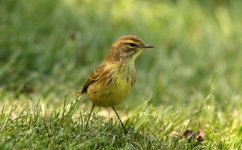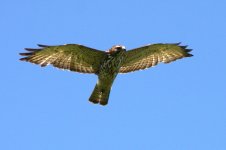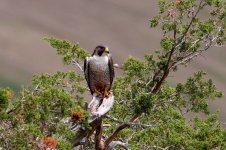Do you go hiking, set up a blind, drive around, set up a feeder, take a safari, or grab a camera when you see something in your yard? I am curious about how other people go about bird photography.
I personally go to a park or trail with trees or water and walk slowly, listening and watching for birds. If I find a spot with activity, or potential activity, I may linger for several minutes. If nothing happens, I move on. Rarely do I stay in one spot, unless it is busy like Grand Central Station. I'm not sure if this is the most effective use of time, but I like seeing different parts of the park and a variety of birds. This requires a readiness to shoot at a moment's notice, and doesn't allow for careful composition nor planning.
Over the course of four years, I've built up a lot of local knowledge through various means: doing a lot of walking from first thing until last thing providing there's sun, scanning the internet for likely locations for certain birds (general areas as opposed to twitching a particular bird), speaking to people who are also out with their cameras (you pick up quite a few bits and pieces that way), local bird twitter sites are always useful, sometimes just sitting around in interesting looking places to see what turns up and a decent amount of the time simply bumping into interesting birds while looking at another bird.
Scanning the internet (general good areas for certain birds as opposed to twitter sites where the latest birds to turn up are advertised) is always useful when you're building your local knowledge. You won't get detailed directions to a bird but you'll get the area and providing your patient and willing to scan areas from morning 'til night, you will find what you're looking for. I've found and photographed Little Owls, Pied Flycatchers, Yellow Wagtails, Ring Ouzels, Green Woodpeckers and plenty of others from that line of enquiry.
Local bird Twitter sites are good for rarer birds that have just turned up. I've seen Taiga Flycatchers, Shrikes, Pied Wheatears and others as a result of the information on those sites, including some decent standard photographs of the Pied Wheatear. I'm not much of a twitcher though, 'not my thing stood around with loads of people jostling for position and so I tend not to make use of that information. I tend to find those Twitter sites more useful for birds that aren't rarities but they're not common either, e.g. wintering Twite, Snow Buntings, Black Redstarts etc (there aren't so many people there for those birds). Again, I've had decent photographs of all of those. You learn that they return to the same place year after year also.
Then there are bits and pieces you pick up from other bird watchers/photographers while you're out, e.g. I was told about good spots to photograph Whinchat and Common Redstart, and they're absolutely outstanding places where those birds come out into the open in positions where you have a decent chance of getting a decent photograph. The Common Redstart one in particular is a beauty, there's never anyone there and it's just me, derelict farms, sheep, birds, fields and woodland for miles. Short-eared Owl is another one where I was given a good tip and whenever I go there, which isn't very often, there's never anyone else there looking. And, you learn good areas for something more unusual coming in simply by taking notice of the more seasoned bird watchers scanning places that seem to be off the beaten track and with no apparent reason to scan those places; but when you build up your knowledge of what birds do, you understand why they're scanning those places.
I've bumped into Long-eared Owls and various other less common birds by complete accident and taken the time to go back a few times and as a result gathered that they nest nearby and so they're there for you whenever you're ready. I've sat around in what I thought were interesting places not looking for anything in particular, and a Barn Owl has come and perched on a fence post; again, by going back a few times you learn that area is part of its hunting patch.
Driving is not a bad way to see birds. I make a point of getting up early and getting on country roads that I know have the habitat nearby and know that I'm pretty much going to be the first person of the day using those roads. I've seen Tawny Owls perched out in the open in daylight not far off the road, Red Kite perched on the side of the road, and plenty of others from starting the morning that way. Now and again, you'll get lucky and the bird will decide you're not a threat: I've photographed Buzzards that way. And on occasion you'll get exceptionally lucky, a Merlin once came and landed on a dead tree in decent range while I was sat watching a Buzzard from my car and stayed there long enough to get a few decent pictures in decent range. I suppose the more effort you put in, the luckier you'll get. I'd never get disheartened because you've spent quite a bit of time and not much has landed for you; you never know what's 'round the corner and something always does happen sooner or later.
Other times, you know the birds are in a small area but you cannot get access to them because they're tucked away. By just giving it a bit of time and 'watching where they go for a while, eventually you'll find a spot where they come out into the open in a good place for photographing. I found a beauty of a spot for Spotted Flycatchers coming out into the open, chasing the flies around and then perching on a fence in the open by doing that. Once you've identified the spot, lie down for a while near it and eventually they won't take much notice of you and you'll have more Spotted Flycatchers perched on fences to go at than you cope with. And, watching where birds feed is a good idea, you'll find they're likely to return to that spot.
And, of course, through experience and taking notice, you learn the best time of the day for certain birds and the best time of spring/summer. When I found Ring Ouzels, for example (through a general look 'round the internet for likely areas), I learned pretty quickly that the best times for them are first thing on the morning until say half ten and in the evening: at those times, they'll alert you to their presence while sat on some grass bank leading down to crag.
I tend to gravitate towards the landscape I like and where there's sun. I prefer to watch the songbirds. I know where all 5 (British) owls are nearby but I very very rarely go to watch them. I'll have a scan for the 'Long-eared Owl being around when I'm in a certain location but that's only because I'm there looking for other birds and so while I'm there I may as well keep my open for the bird hunting; same with a Barn Owl, it's on my way to where I'm going and so I'll stop for half an hour to see if the bird is flying around or perched.
Fortunately, the types of birds I prefer to watch and photograph are in my preferred landscape: Whinchat, Common Redstart, Dipper, King Fisher, Flycatchers and so on. In the spring and summer I can't resist the North Pennies on a sunny day and so spend the vast majority of my time there. I suppose I'm one of those who'd rather watch my favourites birds in my favourite landscape over and over again rather than go for variety.
I should say that I'm quite happy to watch and photograph the more common birds on my doorstep also. I never get tired of seeing Robins and Blackbirds. Stonechat is another common bird that is a beauty: the male and female go 'round like they're joined at hip, and on the odd occasion these birds will help you find something else. 'Just the other day, I was watching a pair of Stonechats and a Black Redstart popped up with them, all feeding in the same area; other times I've seen the odd Whinchat knocking around with Stonechats. And, Stonechats are photogenic and bold: they make a good subject. Kestrel is another one. We have a good number 'round here, and driving down the country roads you'll often see them, beautiful birds that are common but always a pleasure to see. Again, sometimes you'll get lucky and they'll stay perched for you to photograph rather than decide you're a threat. I find the female Kestrels in particular very photogenic when the sun's shining.
When you're working full-time, you only have weekends and you never know when the next sunny day is coming; it is tempting to move from place to place to find something and turn it into a good photograph. I've had a lot more success from staying in one place, watching what the birds are doing and where they're going, particularly where they're feeding; and then thinking about the photograph (how you're going to get into range, background and so on).
Once I've made the decision on which area I'm going to, I stay there for the full day. I don't drive to some other place even though all of those places I've mentioned are within a 30 miles radius. My philosophy is that just because I haven't seen the birds it doesn't mean they're not there: they will turn up eventually. And, the vast, vast majority of my better pictures were taken in the afternoon. I find birds easier to photograph in the afternoon than in the morning when they seem more industrious to me. 'So, I'm never disheartened when nothing has landed right in the morning, I've come to expect it, I'll stay and keep trying.
Which is related to another thing you learn from experience, some birds appear to have an optimum time to photograph them, at least to me anyway. Pied Flycatcher is a good example. I find them impossible to photograph in the morning because they're so industrious and always at the top of trees. They're also difficult to photograph in the afternoon because they seem to go missing. Between say 11 in the morning and midday, they come down from the tops and perch for longer in spots where you have a decent chance of a decent photograph, at least in my experience anyway. As a result, I don't bother going to the Pied Flycatcher spot before 11 in the morning to photograph them because it's nigh on an impossible mission, but I will walk through the woods for 15 minutes in the morning just to hear them singing because it's one of my favourite bird songs. I suppose I go to watch, listen and photograph, and with some birds I've found you're better off watching and listening at certain times of the day and trying to photograph at other times of the day.
If I've been on a good run of form with decent pictures (which means I'm not looking for particular birds to photograph), sometimes I'll just lie near a shrub with blossom in spring, it doesn't matter which bird lands on it you're going to have a beauty of a picture.
All in all, although it hasn't been planned and it's just sort of taken an organic course, I've gone about it by: learning from other people, learning from my own experience, putting plenty of effort in to find good spots, gravitating towards my favourite birds and landscapes, following the sun, concentrating on how to get close to birds and in the right positions rather than getting lost in the camera's technical settings and being quite relaxed about it in the knowledge that at times I'll get lucky and things will land right.
Having said all of that, I'm only scratching the surface of what's there and how to make the most of it. It's easy to get a bit stale and go off the boil which I reckon I've done over the past three or four months but I'm ready to start learning and increasing knowledge again after Christmas Day. I've been pretty lucky though because in the last three or four months of going off the boil, we've had an unusual run of very little sun and when it has been sunny it's been windy a lot of the time as well.
When you say effective use of time, I suppose it depends on your aim. In the event you see pictures of certain birds on the internet or somewhere and you think I wouldn't mind getting some pictures of those birds, then I reckon that it will be far easier for you and far quicker by building up your local knowledge; some of the ways I've mentioned and others have mentioned may help. On the other hand, you may be happy with just watching any birds flying around in the sun, I'm quite happy with that when the mood takes; it will still help to watch the activity of birds, see where they go, see where they feed (they will return to that spot) and you'll find reliable places to photograph birds which may make it a more effective use of time. Oh, and personally, I'd much rather wait for the bird to come into the right place for a photograph (right background, position in relation to the sun etc) and risk not getting a photograph; than take a picture of the bird, as soon as it comes into view, that you might not like that much because of the background, distance and so on. The bird may not land this time by doing that, but it will next time or the next time. 'Better to have one nice picture that you like and want to keep than four that you're not so keen on. At least to me anyway. It's tempting to grab at getting a picture as soon as a bird comes into view, but it's surprising how many times it works out well with a bit of patience!









